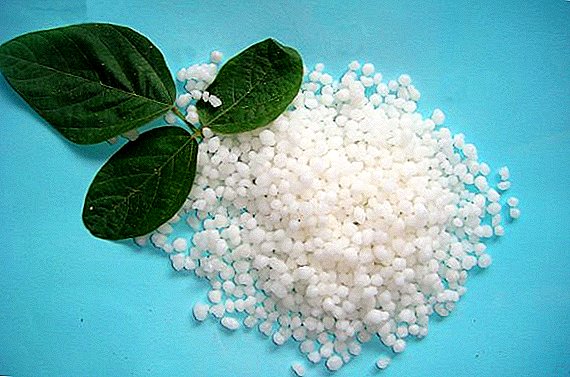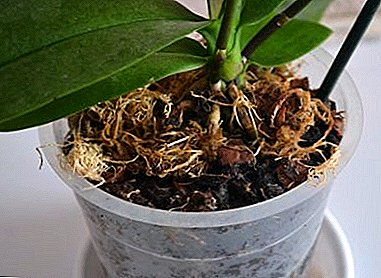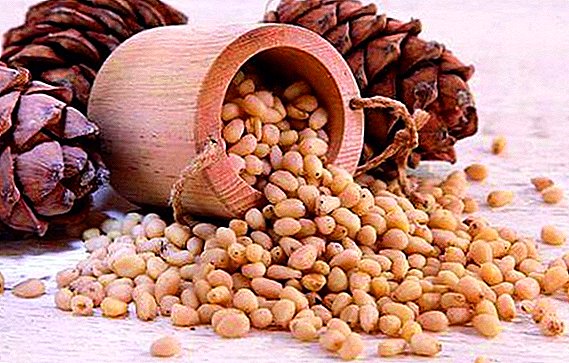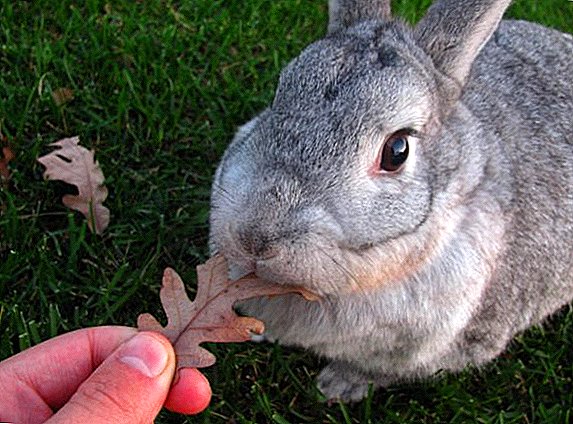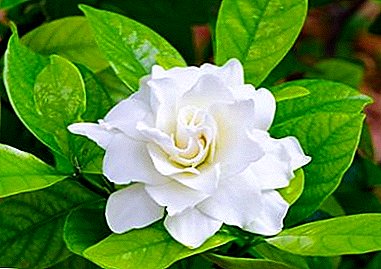
Gardenia is a wonderful ornamental shrub that can be grown in indoor conditions or on outdoor verandas, in the garden. To date, several species of this plant are known, and many varieties have been developed. In the article we will take a closer look at various varieties of gardenia, find out what their features and advantages are.
general information
Gardenia - plants of the marenov family. By itself, this plant is a small shrub - for breeding at home, only low-growing varieties are suitable. The historical homeland of the plant is the southern countries: India, China, Japan, also found in the wild and on the African continent.
Gardenia is valuable, above all, for its amazing decorative appeal. A total of about 250 different species of this plant are known today: all of them have differences in the color of flowers, their shape, and other features.
Most often at home gardenas jasmine, and its many varieties are bred. More rarely - other species: radikans, Kula, citriodor, Hawaiian, etc. Next, we will focus on the most popular varieties of this plant in more detail.
Types and photos of indoor plants
Aimee yoshioka

This gardenia belongs to the most popular type for indoor cultivation - jasmine. The variety was bred relatively recently, however, it has already become popular with our gardeners.
This gardenia is interesting because it can bloom twice a year., which significantly prolongs its decorative period. White flowers resemble a rose in shape, and their aroma is truly delightful.
Brighamii

She comes from Hawaii. A few decades ago, it could be found on all the islands of the Hawaiian archipelago, but to date, in the wild, the plant is found only on a few islands. In height it grows up to 6 meters - you know, it is not suitable for indoor breeding.
The leaves at Brighamii are both light and dark green, which creates the overall impression of a motley tree. The leaves are not pubescent, bare, have light streaks. The flowers are simple, standard white. A distinctive feature of the flowers - their intense, very pleasant aroma.
Radicance

This is one of the most popular "indoor" plant varieties. Due to the miniature size of the gardenia Radikans it is very convenient to grow at home in pots.
Flowers in this type of gardenia unusual - doublethat enhances the spectacular appearance of the plant. Leaves in this case:
- glossy;
- brilliant;
- correct lanceolate form.
Thunberg

Very spectacular view of gardenia: evergreen and fragrant shrub. It has a fairly large size leaves - the correct form, glossy, dark green. The flowers in this case are very beautiful:
- diameter 7-8 cm;
- have the elegant form of a fan;
- snow white.
At night, the fragrance of the flowers of the gardenia of Thunberg is especially strong and nice.
Tahitian

Gardenia of this species is a rare guest in our gardens. However, this plant can boast the largest flowers of all kinds: in diameter, the flowers reach 10 cm.
Particularly spectacular look huge white terry flowers on the broad rounded leaves of dark green color. The aroma of the plant is amazing, this variety deserves special attention of gourmet flower growers.
Variegated

This type of plant is distinguished by decorative white terry flower stalks. At the same time, the leaves at Gardenia Variegata are variegated, which only adds to the plant beauty.
The leaves, moreover, also have a characteristic glossy shine, and their drawing reminds pale yellow marble stains on a dark green background.
Regal

We return to our flowers: the royal gardenia is a magnificent variety with interesting forms of cream-white flowers. It can be attributed to indoor plants.
Can be grown in open groundbut subject to wintering indoors.
Ternifolia

This plant is interesting for its intertwining branches, on which fragrant large flowers are picturesquely scattered.
The variety is very decorative, beautiful, resistant to chlorosis.. Launched "gardenia ternifolia" in Thailand.
Pink

This plant is called "Amoena", refers to a very rare species. The shrub is rarely seen not only from anyone at home or in the garden, but also in huge botanical gardens, where almost all representatives of world flora are gathered.
The trunk and branches of the pink gardenia are equipped with prickles., smooth oval-shaped leaves with pointed tips. Pink flowers are located at the ends of the shoots.
Karinata

Evergreen compact shrub with rarely located fragrant flowers. This type of gardenia is interesting in that its flowers can change color over time: from marble-white they become lemon, then by the end of their life they turn dark orange.
In nature, it grows rather slowly, however, it is capable of vymahat up to 15 meters in height for all its life. As a home potted plant, the species is certainly not cultivated. - this is essentially a tree. Originally from Karinat from Malaysia.
Golden magic

One of the newly cultivated varieties of plants. Golden Magic has leathery fleshy dark green leaves, large double flowers of unusual bright yellow color.
It is interesting that initially the bud blooms with white petals, but over time the latter acquire a deep intense golden hue. The variety is extremely decorative, able to decorate any garden space..
Vietnamese

This shrub has very interesting flowers - they look like six-pointed stars, very picturesque. The shade of flowers - a characteristic white, effectively stands out against the background of dark green foliage.
The plant is compact, well suited for indoor cultivation.. The leaves have an oval regular shape, grow quite densely: on one petiole it usually "huddles" three leaves each. The flowers are very large - reach in diameter and eight centimeters.
The shape of the petals is interesting - they curl up into a tube, thanks to which the whole flower has a star-like appearance.
Care
 Gardenia is considered a capricious and demanding in terms of plant care. Of all its species in the conditions of our apartments, gardenia jasmine can be grown less successfully.
Gardenia is considered a capricious and demanding in terms of plant care. Of all its species in the conditions of our apartments, gardenia jasmine can be grown less successfully.
Basic rules of care:
- The plant does not like temperature fluctuations.
- The soil should always be moderately wet. Equally unacceptable as short-flow and overflow.
- Gardenia prefers acidic soil.
- The place where the flower stands should be brightly lit, but not in direct sunlight.
- The plant feels great in high humidity.
- During the period of bud formation and flowering, the location of the flower should not be changed to avoid fall of the buds.
- The best temperature is 22 degrees in summer and about 18 degrees in winter.
- You can water the flower only with purified (separated or rain) warm water.
Details about the rules of gardening at home and what to do with it after purchase can be found here.
Lighting
Organizing the right lighting for Gardenia is not easy. At the southern window of light it will be enough, but direct sunlight will bring harm. In the north there will not be enough light. Therefore, the best option is east and west. Provide your flower a lot of sun in the summer, do not move it to another place in the winter and it will please for a long time.
Temperature
In winter and summer, the plant requires different temperature conditions. During the warmer months, Gardenia develops and blooms and the air temperature should be +22 degrees. In winter, the flower lays buds for summer flowering and it needs a period of rest, the temperature is 16-21 degrees (see why this gardenia does not bloom and what needs to be done, see this article).
Remember! Air and soil temperatures should be as close as possible to each other. It is impossible to allow overcooling of roots. Also, you need to know that quite a few sudden changes in temperature and the plant will not bloom at all.
Watering and humidity
The irrigation regime for Gardenia is also different in the winter and summer periods. In summer, when the flower is actively growing, watering should be abundant, but the topsoil should completely dry before you water the flower again. In autumn and spring, we water the Gardenia 2-3 days after the topsoil has dried. In winter, watering should be minimal.
Water for irrigation, defend and clean, it should be warm. So that the composition of the soil remains acidic from time to time, lemon juice is added to the water for irrigation (but one cannot overdo it, so as not to harm the plant, just a few drops of juice per liter of water).
The air in the room for gardenia must be humid, which means that it must be sprayed. While the buds are closed this can be done daily. When the flowers open, water droplets that fall on the petals can make them ugly, with brown spots. So, we stop spraying, but we put a container with water next to the plant.
Fertilizer
During the growth and development of plants it is necessary to feed it with liquid fertilizers. Kompleksy for flowering indoor plants, but the dosage should be reduced by half than written in the instructions.
During the period of bud formation and flowering, it is useful to somewhat reduce the acidity of the soil. This will help drugs containing iron. Do this dressing twice per season.
Remember that you can feed a mature plant, ready to receive fertilizers. If the roots of your flower have grown and occupied all the bottom, and moisture is absorbed into the soil very quickly, you can safely feed Gardenia with both mineral and organic fertilizers. These types of dressings are best alternated.
Transfer
 Gardenia does not tolerate transplants at all, and this procedure can be carried out only if absolutely necessary. The flower is very vulnerable, fragile roots, during transplantation, they should be cut off minimally (you can find out how to carry out gardenia at home, here).
Gardenia does not tolerate transplants at all, and this procedure can be carried out only if absolutely necessary. The flower is very vulnerable, fragile roots, during transplantation, they should be cut off minimally (you can find out how to carry out gardenia at home, here).
When transplanting, you need to fill the new pot by about 1/3 of the drainage. The remaining volume - soil with a level of PH4.0-5.5. From the finished soil, you can use the soil mixture for Azaleas (about what kind of soil is needed for gardenia, read here).
If you want to prepare the soil yourself, use the same parts of peat, turf, leaf and coniferous soil, as well as sand.
You can also find out about garden care in this video:
- Why does gardenia have problems with leaves: turn black, turn yellow and fall off?
- What are the most common flower diseases and how to control them?
- Difficulties and secrets of cutting gardenia?
- How to grow gardenia from seed at home?
Conclusion
So, we learned what types of gardenia are particularly popular. Among the varieties of ornamental shrubs "hemmed" and some delicious flavors, a classic old Hollywood movie, and a comfortable hotel in Bulgaria.
But the more information about gardenia in all its manifestations - the better, so we hope that any knowledge about this beautiful flower will be useful.


